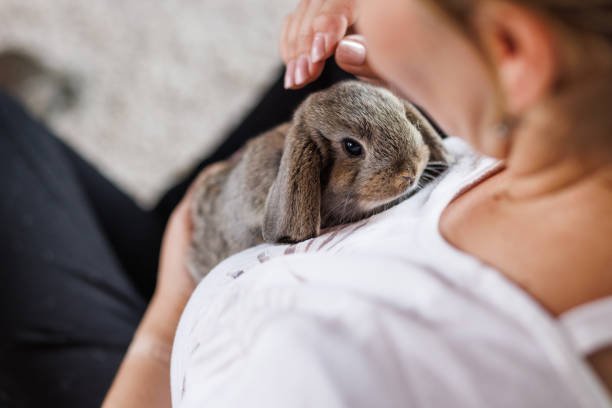Can rescued rabbits be trained for litter box use?

Introduction:
In this article, I’ll explore the fascinating world of training rescued rabbits for litter box use. While cats are often associated with litter boxes, many pet owners are surprised to discover that rabbits can also be taught this convenient habit. Rabbits make wonderful, affectionate companions, but their natural instincts can sometimes lead to challenges when it comes to maintaining a clean living environment.
However, with patience, dedication, and the right techniques, it is indeed possible to train rescued rabbits to use a litter box, making the cohabitation with these adorable creatures more enjoyable and hygienic. We will delve into the reasons behind rabbit litter box training, the essential steps and strategies for success, common obstacles to overcome, and the numerous benefits that come with a well-trained rabbit. Whether you’re a seasoned rabbit enthusiast or a new rabbit parent, this article will provide valuable insights into fostering a harmonious and tidy relationship with your furry friend.
Rescued rabbits and litter box training:
Rescued rabbits often find themselves in new homes after experiencing various challenges and traumas. Litter box training is a crucial aspect of their rehabilitation and integration into their new environment. When these rabbits come into the care of loving owners, many may wonder if it’s even possible to train them to use a litter box. The answer is a resounding yes, and it’s a process that can greatly improve the quality of life for both the rabbit and the owner.
Litter box training helps ensure a cleaner and more hygienic living space for the rabbit while facilitating a more harmonious cohabitation with their human companions. This training not only reduces stress for the rabbit but also enhances their overall well-being. It is an essential skill to develop, especially in multi-pet households where other animals might not share the same litter box habits. With the right approach and understanding of rabbit behavior, rescued rabbits can successfully be trained for litter box use.
Rabbit instincts and challenges:
To understand the challenges and intricacies of litter box training for rescued rabbits, it’s vital to grasp their natural instincts and behaviors. Rabbits are prey animals, and their instincts are deeply rooted in the wild. They tend to establish a specific area within their territory for urination and feces to avoid attracting predators. This natural instinct is a valuable starting point for litter box training.
However, challenges arise due to the territorial nature of rabbits. They may mark their territory by leaving droppings in various spots, especially if they are not spayed or neutered. This territorial behavior can make litter box training a bit more complex, as it involves modifying their instinctual behaviors. Additionally, the age and prior experiences of rescued rabbits can impact the ease with which they adapt to litter box use. Understanding these instincts and challenges is key to developing effective training strategies.
The possibility of successful training:
It’s crucial to establish that successful litter box training is indeed possible for rescued rabbits. Whether you’ve recently adopted a rabbit or you’re providing a safe haven for a rescued one, with patience, consistency, and the right approach, most rabbits can be trained to use a litter box. This training is not limited to young rabbits; even older or rescued rabbits can learn the habit.
The possibility of success hinges on several factors, including the rabbit’s age, prior experiences, and any medical conditions that may affect their bladder control. While some rabbits may pick up litter box habits quickly, others might require more time and effort. The key is to be persistent and tailor your training approach to the individual needs and behaviors of the rabbit. With a positive mindset and a well-considered plan, you can increase the likelihood of achieving success.
Importance of patience and dedication:
Training any animal, including rescued rabbits, demands patience and dedication. Litter box training is no exception. It’s essential to remember that each rabbit is unique, and their learning pace can vary. For rescued rabbits, especially those who may have experienced neglect or trauma, additional patience may be required.
Consistency is another critical factor. Setting a routine for training sessions and using positive reinforcement techniques can help the rabbit understand what is expected of them. Expect some setbacks and accidents along the way, and be prepared to adjust your approach accordingly. Remember that training is a gradual process, and the rabbit’s well-being and comfort should always be the top priorities. With time, patience, and a commitment to their training, you can help your rescued rabbit become a litter box pro.
Essential steps for training:
Successfully training a rescued rabbit to use a litter box involves a series of essential steps. First, you’ll need to select an appropriate litter box and choose the right type of litter. The litter box should be of an appropriate size, easily accessible, and placed in a quiet, safe area where the rabbit can have privacy.
Introducing the rabbit to the litter box is the next step. Allow the rabbit to explore the box and get used to it before expecting them to use it for elimination. Once they show interest, you can encourage them to use it by placing some of their droppings in the litter box. Positive reinforcement is key, and whenever the rabbit uses the litter box, offer praise and treats.
Consistency is crucial, and maintaining a routine for the rabbit’s feeding and bathroom breaks can help with training. Gradually, you can expand the rabbit’s living space while ensuring that litter boxes are strategically placed throughout their territory. This gradual expansion of the litter box area can be an effective way to promote good litter box habits.
Effective training techniques:
Effective training techniques for litter box use involve a combination of positive reinforcement, patience, and understanding of the rabbit’s behavior. Positive reinforcement means rewarding the rabbit when they use the litter box correctly. This can be done with verbal praise, gentle petting, or small treats. Avoid negative reinforcement or punishment, as it can create anxiety and hinder the training process.
You can also use scent and location to your advantage. Rabbits tend to return to the same spot if they smell their own waste. So, placing some droppings in the litter box will signal that it’s an appropriate place for elimination. Additionally, rabbits often prefer to urinate in corners, so positioning the litter box in a corner can be helpful.
Observing your rabbit’s behavior is crucial. Watch for signs that they are about to eliminate and gently guide them towards the litter box. Be patient and consistent, and over time, the rabbit will become more adept at using the designated area for bathroom activities.
Common obstacles to address:
Litter box training can present various challenges, and understanding these obstacles is essential for success. One common issue is territorial marking, especially in unspayed or unneutered rabbits. They may use droppings to establish their territory. Spaying or neutering can help reduce this behavior, making litter box training more manageable.
Inconsistent litter box use is another challenge. Rabbits might have occasional accidents, particularly if their routine is disrupted or if they are stressed. In such cases, it’s essential to address the underlying causes of stress and provide support and comfort to the rabbit.
Health issues can also interfere with litter box training. Rabbits with urinary tract problems may have difficulty controlling their bladder. If your rabbit’s litter box habits change suddenly, consult a veterinarian to rule out any medical issues.
Benefits of a litter-trained rabbit:
Training a rescued rabbit to use a litter box offers a multitude of benefits for both the rabbit and the owner. For the rabbit, it provides a cleaner and more comfortable living environment, reducing stress and promoting overall well-being. Litter-trained rabbits are also more likely to have a stronger bond with their owners, as they can interact in a cleaner and odor-free space.
For the owner, a litter-trained rabbit means less time spent cleaning up after your pet and a more pleasant living experience. It’s especially valuable for those living in apartments or smaller spaces. Additionally, a rabbit with good litter box habits can coexist more harmoniously with other pets, reducing potential conflicts.
Conclusion:
I hope this article has shed light on the possibility of training rescued rabbits for litter box use and provided valuable insights into the essential aspects of this process. While it may present some challenges, it is indeed a feasible and rewarding endeavor.
Understanding the natural instincts and behaviors of rabbits is fundamental in this journey, and with patience and dedication, the likelihood of success significantly increases. Remember that each rabbit is unique, and their training pace may vary, so consistency and positive reinforcement are key.
Successfully litter-training a rescued rabbit not only ensures a cleaner and more hygienic living space but also contributes to the well-being of your furry companion. The benefits extend to a stronger bond with your pet, reduced stress for both the rabbit and owner, and enhanced cohabitation in multi-pet households.










Post Comment